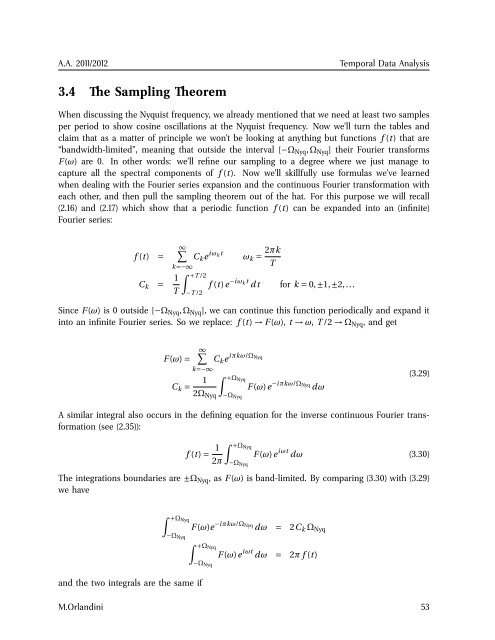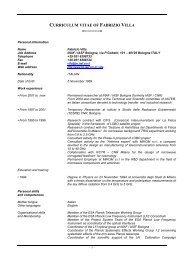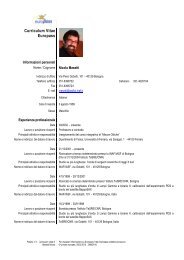booklet format - inaf iasf bologna
booklet format - inaf iasf bologna
booklet format - inaf iasf bologna
You also want an ePaper? Increase the reach of your titles
YUMPU automatically turns print PDFs into web optimized ePapers that Google loves.
A.A. 2011/2012<br />
Temporal Data Analysis<br />
3.4 The Sampling Theorem<br />
When discussing the Nyquist frequency, we already mentioned that we need at least two samples<br />
per period to show cosine oscillations at the Nyquist frequency. Now we’ll turn the tables and<br />
claim that as a matter of principle we won’t be looking at anything but functions f (t) that are<br />
“bandwidth-limited”, meaning that outside the interval [−Ω Nyq ,Ω Nyq ] their Fourier transforms<br />
F (ω) are 0. In other words: we’ll refine our sampling to a degree where we just manage to<br />
capture all the spectral components of f (t). Now we’ll skillfully use formulas we’ve learned<br />
when dealing with the Fourier series expansion and the continuous Fourier trans<strong>format</strong>ion with<br />
each other, and then pull the sampling theorem out of the hat. For this purpose we will recall<br />
(2.16) and (2.17) which show that a periodic function f (t) can be expanded into an (infinite)<br />
Fourier series:<br />
f (t) =<br />
C k = 1 T<br />
∞∑<br />
C k e iω k t<br />
k=−∞<br />
∫ +T /2<br />
−T /2<br />
ω k = 2πk<br />
T<br />
f (t)e −iω k t dt for k = 0,±1,±2,...<br />
Since F (ω) is 0 outside [−Ω Nyq ,Ω Nyq ], we can continue this function periodically and expand it<br />
into an infinite Fourier series. So we replace: f (t) → F (ω), t → ω, T /2 → Ω Nyq , and get<br />
∞∑<br />
F (ω) = C k e iπkω/Ω Nyq<br />
k=−∞<br />
C k = 1 ∫ +ΩNyq<br />
F (ω)e −iπkω/Ω Nyq<br />
dω<br />
2Ω Nyq<br />
−Ω Nyq<br />
(3.29)<br />
A similar integral also occurs in the defining equation for the inverse continuous Fourier trans<strong>format</strong>ion<br />
(see (2.35)):<br />
f (t) = 1 ∫ +ΩNyq<br />
F (ω)e iωt dω (3.30)<br />
2π −Ω Nyq<br />
The integrations boundaries are ±Ω Nyq , as F (ω) is band-limited. By comparing (3.30) with (3.29)<br />
we have<br />
∫ +ΩNyq<br />
and the two integrals are the same if<br />
−Ω Nyq<br />
F (ω)e −iπkω/Ω Nyq<br />
dω<br />
∫ +ΩNyq<br />
= 2C k Ω Nyq<br />
−Ω Nyq<br />
F (ω)e iωt dω = 2π f (t)<br />
M.Orlandini 53

















